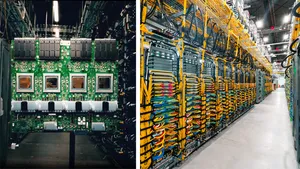What happened at Google Cloud Next ‘18

Today at Next ‘18, we were especially excited to celebrate the developers who build on Google Cloud. We got a peek at some developer tricks on stage today, plus some fun demos—one of which built a natural language-enabled weather web app in just 15 minutes. We’re looking forward to continuing to grow our developer community and bringing you the information and tools you need to build what’s next.
Better building in the cloud
Google Cloud is a great place to run your apps, and it’s an equally great place to build them. Now, with our revamped Cloud Build CI/CD service, you have an easy, high-performing and flexible service that lets you build container and non-container based apps.
What we announced
We provided a deeper look at Cloud Build, our fully managed continuous integration and continuous delivery (CI/CD) platform that lets you build and test applications in the cloud—at scale.
We’re integrating Cloud Build with GitHub, making it easy to add CI processes on top of your GitHub code repository.
A look inside Next
Next ‘18 is three days packed full of talks, bootcamps and breakout sessions (more than 500 in total!). We thought we’d give you a look at what it’s like to be here on the ground at Moscone Center.
What our customers are saying
Here are a few of our favorite sound bites from day three:
“Not only do we believe that Google Cloud is the right cloud for our customers, but we’re also migrating our infrastructure over to Google Cloud. Together, we’re making it easier for you to build and operate your connected experiences.” —Suhail Dutta, VP of Cloud Services, Unity
“Kubernetes Engine had exactly the API that we needed. […] Give me a cluster. Here are my compute and memory requirements. Go. Kubernetes Engine gives me a cluster. Now I need a place to store my customer’s data and keep it backed up. Cloud Storage is right there. Now I need isolation so I can manage and bill each of our customers separately. We use GCP’s projects within our Google Cloud organization to keep our customers’ resources isolated. [As a result] a single team of three developers built and shipped an all-new npm Enterprise, and it’s serving customers now.” —CJ Silverio, CTO, npm Inc.
Thanks to all who attended Next ‘18, and to everyone who joined us online through our blogs and live stream. We hope to see you in 2019!
What happened at Google Cloud Next ‘18: Day 2
Whether it’s 20th Century Fox creating machine learning models in 30 seconds or GO-JEK generating 4 terabytes of events data each day as they zip around Jakarta, our customers are doing amazing things (including arriving on stage on a scooter!). Today’s announcements and updates are bringing you lots of new features so you can build and expand how you use the cloud.
Better building in the cloud
Google Cloud Platform (GCP) makes it easier to build applications your way with expanded database options and features that bring flexibility and performance. And you can now run more types of workloads than ever on GCP, thanks to new partnerships and integrations.
What we announced
We’ve partnered with managed service providers (MSPs) so you can now run Oracle workloads on GCP using dedicated hardware.
Our Intel and SAP collaboration means you’ll be able to run SAP HANA workloads on Compute Engine VMs powered by Intel Optane DC Persistent Memory for more capacity at lower cost.
We’ll soon expand the availability of the Cloud Firestore beta to more users by bringing the UI to the GCP console, letting you store, sync and query data for cloud-native apps. Plus, Cloud Firestore will soon support Datastore Mode, bringing better app performance and strong consistency.
Regional replication across zones is now available for Cloud Bigtable, our massively scalable NoSQL database. Also available is the beta version of Key Visualizer for Cloud Bigtable, which helps debug performance issues by mapping key access patterns.
Compute Engine now uses a resource-based pricing model, so your costs will be based on how many resources you consume over a given time period, giving customers more savings and a simpler bill.
AI for every business
We’re helping our users train their machine learning models faster, in multiple locations (on-prem, and multi-cloud with Kubeflow), and with more libraries (XGBoost and scikit-learn on Cloud ML Engine). We’re also extending classification to IoT and gateway devices at the edge.
What we announced
Cloud TPU Pods and TPU v3 are now available in alpha, allowing you to train models faster on Cloud ML Engine.
We now support both training and online prediction through scikit-learn and XGBoost in Cloud ML Engine.
Kubeflow v0.2 makes it easier to use machine learning software stacks on Kubernetes.
Our partnership with Iron Mountain helps enterprises extract hard-to-find information from inside their stored documents.
The Edge TPU is a tiny ASIC chip designed to run TensorFlow Lite ML models at the edge. (As Injong Rhee demonstrated in his keynote, four of them can fit on a penny!)
Cloud IoT Edge extends Google Cloud’s powerful AI capability to gateways and connected devices.
Reimagining how we work
We know that enterprises want to move to cloud-first collaboration, but, understandably, they have questions about how to make it happen in a business of their size. What happens with email security? How can they manage their data? How does G Suite work with the tools and systems they already have in place? These new additions in G Suite are specially built to help address these common concerns.
What we announced
Features in the new Gmail, like redesigned security warnings, snooze and offline access, are now generally available to G Suite users to help them collaborate more securely and efficiently.
New functionality in Cloud Search to help companies intelligently and securely index third-party data beyond G Suite (whether the data is stored in the cloud or on-premises). This functionality is being deployed to an initial set of customers.
Google Voice to G Suite—an enterprise version of Google Voice—is available in an Early Adopter Program today. It lets admins manage users, provision and port phone numbers, access detailed reports and more.
A new, standalone Drive Enterprise with usage-based pricing is generally available today to help companies easily transition data from legacy enterprise content management (ECM) systems.
G Suite Enterprise for Education is expanding to 16 new countries.
From data to insights
Data growth in the enterprise is staggering, and as businesses generate more data each year, they need advanced tools to store, manage, analyze, and generally make sense of it all. Today, we announced a number of enhancements to our data analytics offerings aimed at helping businesses uncover important insights from their data.
What we announced
BigQuery ML is a new capability that allows data analysts and data scientists to easily build machine learning models directly from BigQuery with simple SQL commands, making machine learning more accessible to all. BigQuery ML is now available in beta.
BigQuery Clustering enables you to group rows by common keys for faster query speeds.
BigQuery GIS is now available in public alpha to let you handle geographic data types.
A Sheets data connector for BigQuery is now available in beta, letting you access your BigQuery data warehouse straight from Sheets.
Data Studio Explorer, now in beta, supports templates and a one-click visualization tool.
Cloud Composer, a managed Apache Airflow service, is now generally available to help you orchestrate your multi-cloud deployment strategy.
Customer Managed Encryption Keys for Dataproc (generally available for BigQuery, and in beta for Compute Engine and Cloud Storage) gives you granular control over provisioning and revoking identity-aware authentication keys to your teams and users.
We announced streaming analytics updates, including Dataflow Streaming Engine in beta and Python support in general availability.
Dataflow Shuffle is now generally available to help customers run bigger and faster batch jobs.
Dataproc Autoscaling, in alpha, gives users Hadoop and Spark clusters that scale automatically, and Dataproc Custom Packages, also in alpha, allows customers to deploy a selection of top-level Apache components quickly through a checkbox-like selection experience within Dataproc.
A more secure cloud
Having trust in your cloud provider is multi-faceted—the result of our operating philosophy, the policies we enact and the tools we provide. Today, we announced a variety of security tools and capabilities, so you can trust the integrity of your data, your users, and your operating environment.
What we announced
Context-aware access lets you control access based on user’s identity, location, and the context of their request.
To help protect high-value users like admins, we created the Titan Security Key, a FIDO security key with firmware developed by Google to verify its integrity.
Shielded VMs help you ensure that your virtual machines have not been tampered with or compromised.
Enforce signature validation when deploying container images with Binary Authorization.
Container Registry Vulnerability Scanning helps prevent images from being deployed that contain vulnerabilities.
Geo-based access control in Cloud Armor, our DDoS and application defense service, lets you control access to your services based on the location of the client trying to connect to your application.
Cloud HSM is a fully managed service so you can protect your most sensitive workloads without needing to manage a hardware security module (HSM) cluster.
Access Transparency, now generally available, provides an audit trail of actions taken by Google Support and Engineering when they interact with your data and system configurations on Google Cloud.
What our customers are saying
At Next ‘18 we’re joined by more than 290 customer speakers. Here are a few of our favorite quotes from day two:
“AutoML met our unique requirements in a very short timeframe. We needed a custom solution. We can now find our documents in seconds instead of weeks, giving us the freedom to make well-informed and timely decisions, and transforming the way business decisions are made at Chevron.” —Laura L. Bandura, Ph.D Research Geophysicist, Chevron
“We did an extensive technical evaluation with a bunch of our engineers over many months and found that GCP performed the best for our specific use case around ad-hoc analysis. We believe the throughput of GCP’s network and storage solutions was the primary reason for this performance. In fact, the network performance was so good that we’re able to decouple storage and compute. This architectural flexibility is a huge advantage for us. We can now scale storage and compute independent of each other and also run multiple data processing frameworks on the same data more easily.” —Parag Agrawal, CTO of Twitter
“I believe that brands like ours that are constantly bringing new products to market must be able to use machine learning models to drive faster decisions at scale, using the tools they are most comfortable with. That is what BigQuery ML has enabled us to do.” —Miguel Angel Campo-Rembado, SVP of Data Science & Analytics at 20th Century Fox
Check back here for more news tomorrow!
What happened at Google Cloud Next ‘18: Day 1
What a way to kick off Next ‘18. We started by welcoming our community of leaders, developers, and entrepreneurs to Moscone Center in San Francisco. As Diane Greene mentioned in her keynote, it was Google’s biggest event ever, with more than 25,000 registrants. We learned how the cloud is reimagining work, rethinking the contact center, and redefining what’s possible for many of our customers. (Plus, there was a surprise visit from Sundar.) Read on for the highlights.
Better building in the cloud
Cloud computing is so much more than outsourced infrastructure—it promises agility, reliability and scale. We want to deliver on that promise, so today, we announced Cloud Services Platform, a set of foundational services and technologies that deliver advanced operational and management capabilities to your IT environment, in the cloud and on-premise. Read more in our Cloud Services Platform and serverless announcements.
What we announced
We’re introducing a service mesh based on the open-source Istio, which will soon move to version 1.0, and Managed Istio, a fully managed version thereof, running in GCP. Also, Apigee API Management for Istio lets enterprises operationalize microservices created by the Istio service mesh with their existing API management tools.
For Istio and App Engine workloads, the new Stackdriver Service Monitoring provides an SRE-inspired, service-oriented view of your workloads, showing you how your end users experience your systems.
We’re furthering hybrid computing with GKE On-Prem, a Google-configured version of Kubernetes that includes multi-cluster management, that you can deploy on-premise or in other clouds.
GKE Policy Management establishes a single source of truth for the policies that govern your Kubernetes workloads, across any enrolled cluster.
We want you to build all your applications serverlessly, even if you use Kubernetes. To help you do that, we will offer the new GKE serverless add-on. Then, we’re releasing that same serverless framework as open-source under the name Knative.
Speaking of serverless, we’re adding support for Python 3.7 and PHP 7.2 runtimes on App Engine standard environment.
Cloud Functions is now generally available, with support for additional languages, plus performance, networking and security features.
Serverless containers on Cloud Functions allow you to run container-based workloads in a fully managed environment and still only pay for what you use.
Cloud Firestore lets you store and sync your app data at global scale, with access within the GCP Console coming soon.
Finally, Cloud Build is our new continuous integration/continuous delivery (CI/CD) service that’s integrated with popular developer tools and that lets you build serverless applications.
AI for every business
Empowering businesses and developers to do more with AI means providing them with tools that make it possible to take advantage of machine learning, regardless of skill level or expertise. Read more in our AI and Contact Center blog posts.
What we announced
Cloud AutoML Vision, Natural Language, and Translation extend powerful ML models to suit specific needs, without requiring any specialized knowledge in machine learning or coding.
TPU V3s, our custom ASIC chips designed for machine learning workloads, are in alpha.
New enhancements to Dialogflow Enterprise Edition enable you to design smarter and more conversational interfaces.
A new solution, Contact Center AI, which includes new Dialogflow features alongside other tools to assist live agents and perform analytics.
Reimagining how we work
In order to stay competitive, companies are reimagining how their global teams work together using cloud-native collaboration in G Suite that’s smart, simple and secure. Proactively protect against security threats, manage where company data is stored and shared and communicate more effectively with these new, assistive capabilities in G Suite. Read more in this post from G Suite.
What we announced
A new investigation tool in the Security Center helps admins identify which users are potentially infected, see if anything’s been shared externally and remove access to Drive files or delete malicious emails.
Customers can choose where to store primary data for select G Suite apps—globally, distributed, U.S. or Europe—with Data Regions for G Suite.
Smart Reply is coming to Hangouts Chat. Using AI, Smart Reply recognizes which messages need responses and proposes reply options that are casual enough for chat, yet appropriate for the workplace.
Smart Compose in Gmail intelligently autocompletes emails for you—by filling in greetings, common phrases and more–so you collaborate more efficiently. Smart Compose will be available to G Suite customers in the coming weeks.
Grammar Suggestions in Google Docs uses a unique machine translation-based approach to recognize grammatical errors (simple and complex) and suggest corrections. It is available in an Early Adopter Program (“beta”) for G Suite customers today.
Voice Commands for Hangouts Meet hardware brings some of the same magic of the Google Assistant to the conference room so that teams can connect to video meetings quickly. Voice Commands will roll out to select Meet hardware customers later this year.
What our customers are saying
At Next ‘18 we’re joined by more than 290 customer speakers. Here are a few of our favorite quotes from day one:
“My guys love working with your team. We’ve learned a lot from Google about site reliability engineering. But more than that, I think it’s the commitment to open source—that made all the difference. At the end of the day, it wasn’t me who chose Google, it was my engineers. Google was important to the engineering team, so it mattered to me.” —Mike McNamara, Executive VP, Chief Information and Digital Officer, Target
“[Visiting your midwest data center] made us realize Google was operating at a totally different scale. I also came to appreciate how much security was involved at every single point. Security to get into the complex. Security for each server. And security for destroying drives that were no longer being used.” —Bernd Leukert, Member of the Executive Board, Products & Innovation, SAP SE
"We have 95 years of innovation. As the world and consumers change, we have to change too. My job is to make sure over 40,000 associates in over 100 countries have the most robust tools to innovate and service our clients… [we needed] a collaboration platform that allows our employees to connect anytime, anywhere on any device. That led us to G Suite." —Kim Anstett, Chief Information Officer, Nielsen
“Standardizing monitoring signals lets us monitor across our systems, correlate logs, and do distributed tracing. But these monitoring concepts requires services to communicate in a standard way. With Istio…We have a uniform and transparent mechanism to collect metrics and logs…and are running it in production.” —Jeff White, Software Engineer, eBay
We’ll be updating this post all week as it happens at Next ‘18. Check back here tomorrow for the latest news from the event.






